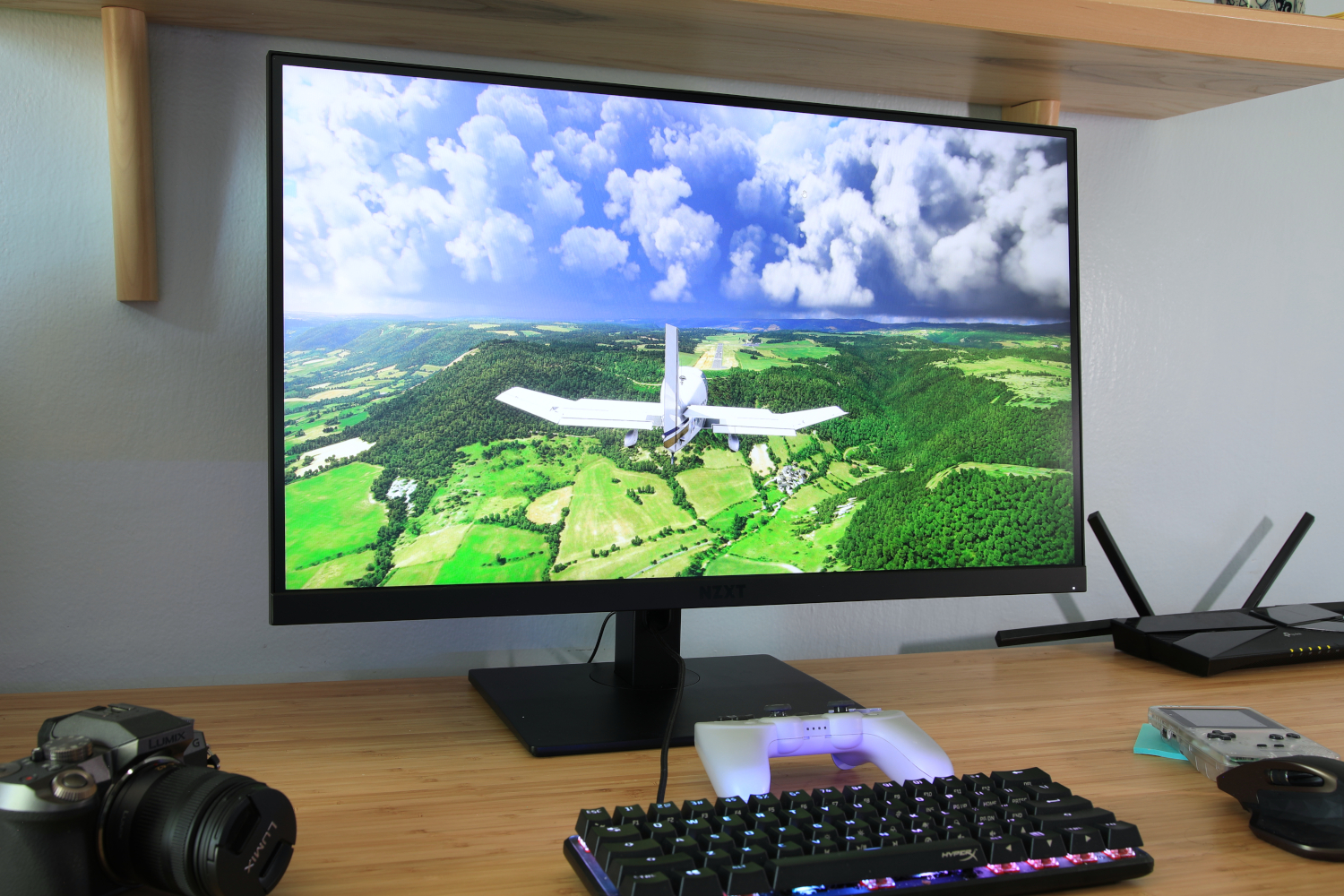 At a glance
At a glanceExpert's Rating
Pros
- Handsome design with functional stand
- Attractive SDR image quality
- Good motion clarity at 165Hz
- Supports all Adaptive Sync standards
Cons
- No USB connectivity or 3.5mm audio-out
- Lackluster HDR
Our Verdict
The inexpensive Dell G2724D provides good image quality, strong motion clarity, and broad Adaptive Sync support at an obtainable price.
Best Prices Today: Dell G2724D
Gamers looking to buy a monitor on a budget have a lot of choices, but sorting through them can be difficult. Small flaws and details can hold back the appeal of many inexpensive monitors. The Dell G2724D is an alluring and reliable budget pick that delivers everything gamers expect and has no significant flaws.
Further reading: See our roundups of the best budget monitors and best gaming monitors to learn about competing products.
Dell G2724D specs and features
The Dell G2724D’s specifications are typical for a budget gaming monitor sold at $300 or less. It provides 1440p resolution, a 165Hz refresh rate, and supports HDR—though it’s only certified for VESA DisplayHDR 400, which is the lowest level of certification provided by VESA.
- Display size: 27-inch 16:9 widescreen
- Native resolution: 2560×1440
- Panel type: IPS LCD
- Refresh rate: 165Hz
- Adaptive Sync: VESA Adaptive Sync, AMD FreeSync Premium, Nvidia G-Sync Compatible
- HDR: Yes, VESA DisplayHDR 400
- Ports: 1x HDMI 2.1, 2x DisplayPort 1.4
- VESA mount: Yes, 100x100mm
- Speakers: None
- Price: $299.99
There is just one specification that stands out, and that’s Adaptive Sync. Dell lists official support for VESA Adaptive Sync, AMD FreeSync Premium, and Nvidia G-Sync. Most budget monitors only bother to support AMD FreeSync.
Dell G2724D design
The Dell G2724D has a matte black and gray chassis with racy vents along the rear panel that remind me of window louvers on a vintage sports car. It’s appealing and aggressive, yet not so bold that it looks wildly out of place in a home office or living room.
Build quality is commendable. The chassis is entirely plastic, which is true of nearly all monitors, but most surfaces feel rigid and the monitor doesn’t creak or groan in protest when it’s picked up. Though inexpensive, the G2724D’s look and feel is comparable to many gaming monitors sold for twice the price.
Dell includes an ergonomic stand that adjusts for height, tilt, swivel, and can pivot 90 degrees for use in portrait orientation. The stand is compact and requires minimal space, and the stand base is relatively flat, which leaves most of your desk usable when the monitor is in place. A 100x100mm VESA mount is also included for use with third-party monitor stands and arms.
Though inexpensive, the G2724D’s look and feel is comparable to many gaming monitors sold for twice the price.
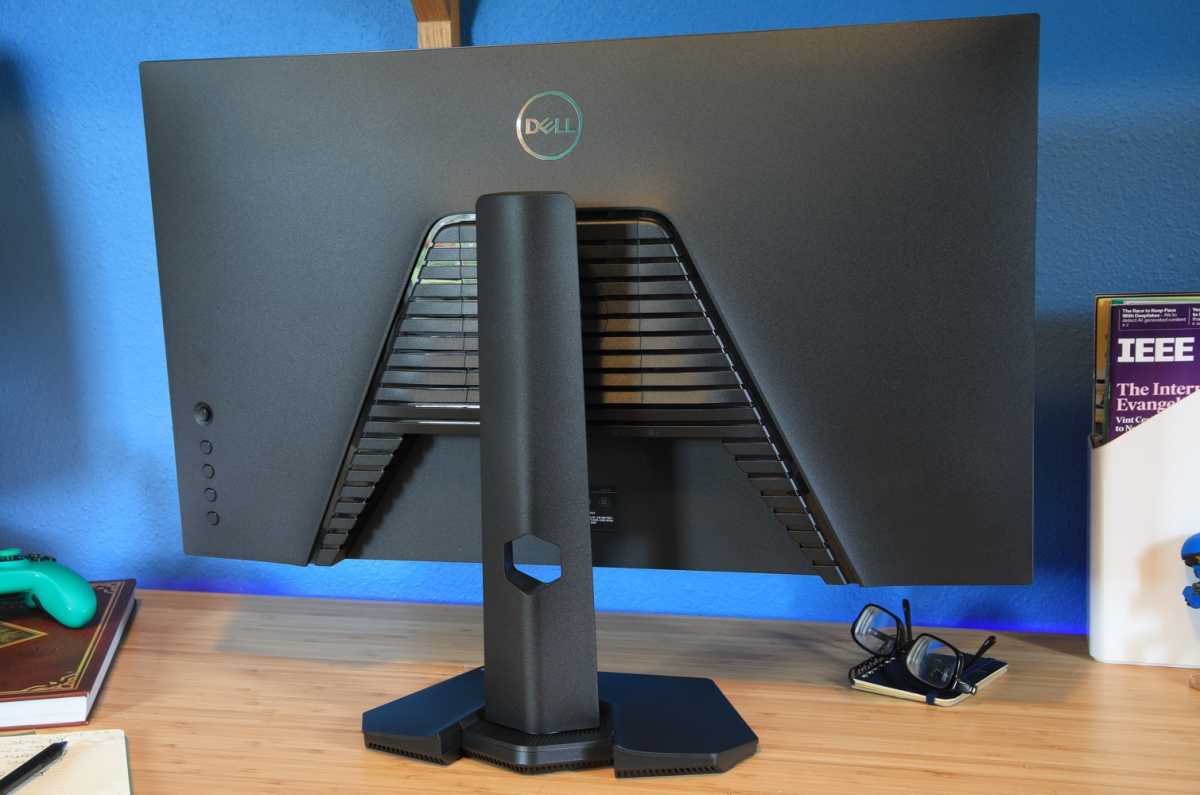
It’s not often that a budget monitor offers attractive design details like the sporty vents on the back of the Dell G2724D.
Matt Smith/Foundry
Dell G2724D features and menus
Dell equips the G2724D with a single HDMI 2.1 port and two DisplayPort 1.4 connections. Only the DisplayPort connections can handle the maximum refresh rate of 165Hz, while the HDMI provides a maximum of 144Hz.
Connectivity is otherwise limited. The monitor doesn’t include a 3.5mm audio-out jack. USB is missing, as well. This lack of additional connectivity is understandable given the monitor’s price, but most competitors offer these ports.
The G2724D’s menu system is easy to navigate thanks to a joystick located on the rear right side of the monitor. The joystick is flanked by several buttons that provide shortcuts or can be used to assist in navigation. Dell also offers a software tool, Dell Display Manager, that can adjust many monitor settings within Windows. Finding and adjusting settings is rarely a chore and the menu system is more responsive than those found on competitors like AOC, Gigabyte, and Acer’s Nitro sub-brand, to name a few.
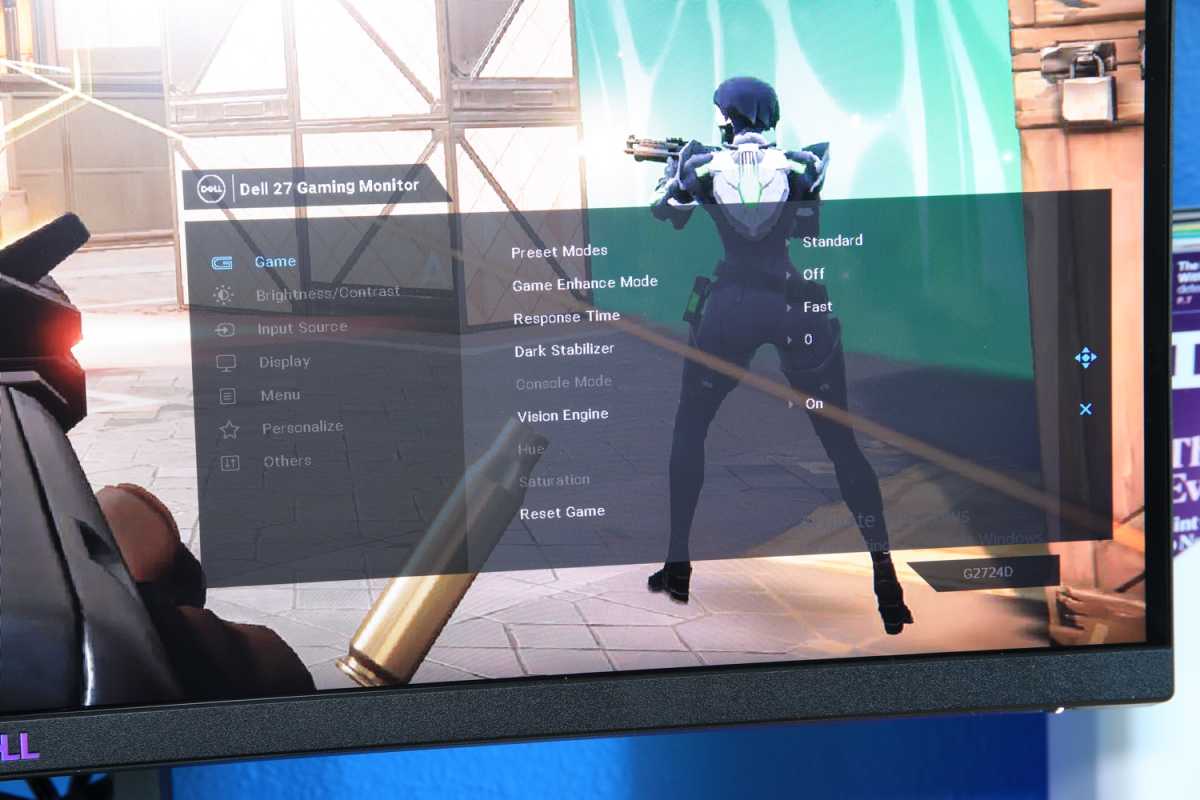
Matt Smith/Foundry
The monitor offers a healthy range of customization options including color saturation, hue, gain, and offset (though only in custom color mode). The monitor also provides gamma and color temperature adjustments. Gaming features include black equalizer, which is designed to enhance brightness in dark scenes so that details are more visible, and Chroma Vision, which dramatically alters the image to make hidden enemies noticeable. An on-screen crosshair is available, too.
Speakers aren’t included. That might seem like a drawback, but budget gaming monitors that include speakers fail to deliver usable audio quality, so their absence is easy to excuse. Gamers shopping for a monitor in this price range should expect to add desktop speakers or use a headset.
Dell G2724D SDR image quality
Although the Dell G2724D is inexpensive, SDR image quality is critical as gamers will expect an immersive visual experience. Fortunately, the monitor is up to the task, providing good image quality in a variety of content and avoiding potential pitfalls.

Matt Smith/Foundry
The G2724D’s maximum brightness of 438 nits is much higher than alternatives in this price bracket and, combined with the monitor’s matte display coat, should make the display easy to view even in a bright, sunlit room.
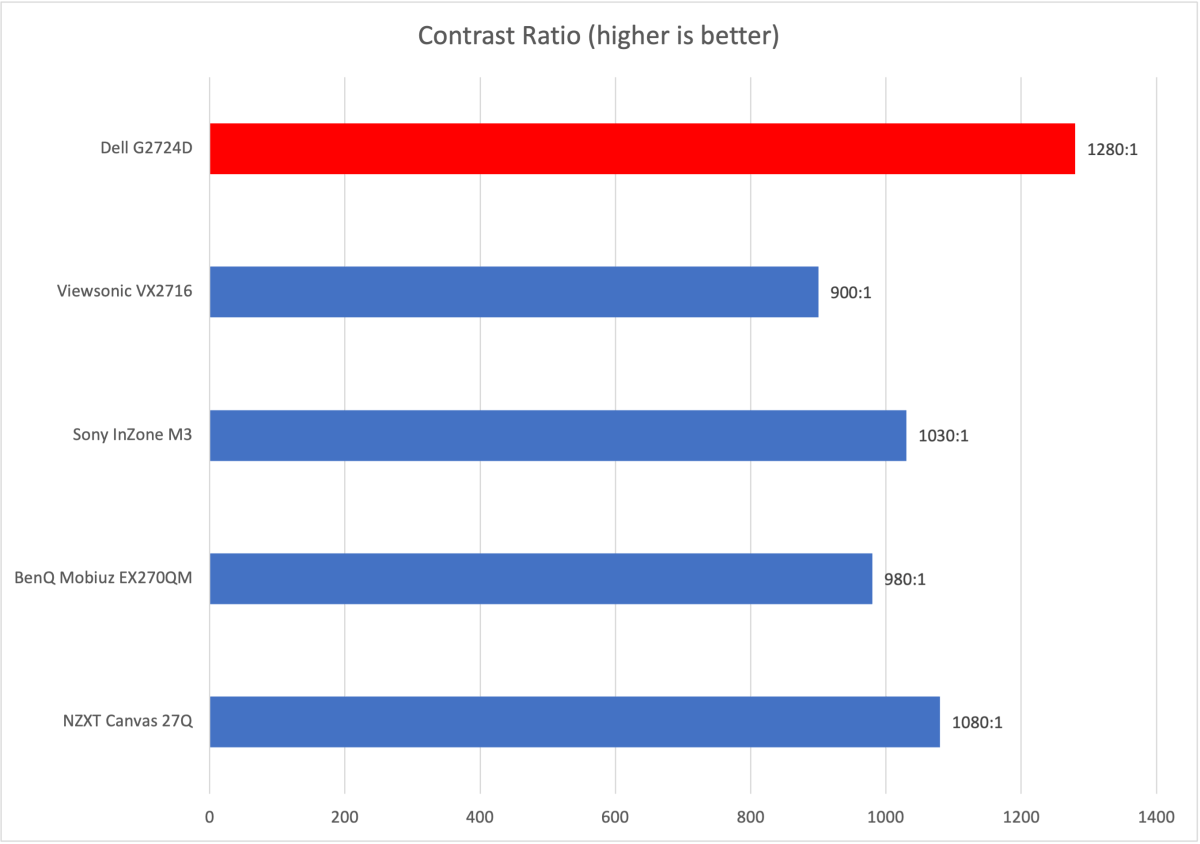
Matt Smith/Foundry
I recorded a maximum contrast ratio of 1280:1, which is a strong result for a budget gaming monitor and defeats alternatives within this price bracket.
The G2724D can deliver a sense of depth and dimensionality lacking in other budget gaming monitors, which can look dull and flat by comparison. It’s best when displaying bright, vivid content in a lit room, as this obscures the monitor’s inability to reach low levels of luminance in dark scenes.
Gamers who play in a dark room are likely to notice a hazy gray look present in dark scenes. This is known as “IPS glow” and is common to all IPS monitors with a conventional edge-lit LED backlight. However, the problem is slightly less noticeable on the G2724D than on most budget monitors.
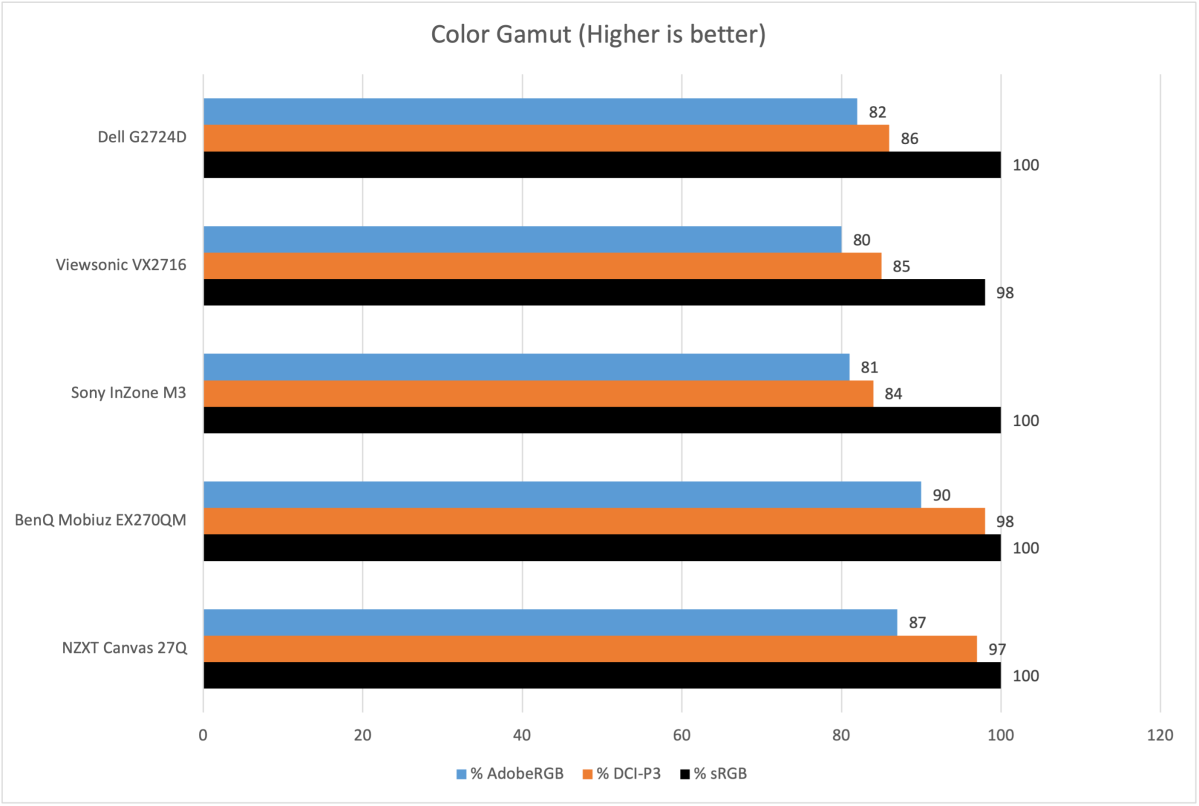
Matt Smith/Foundry
The G2724D’s color gamut spans 100 percent of sRGB, 86 percent of DCI-P3, and 82 percent of Adobe RGB. That’s not enough to qualify as a wide gamut monitor, but it’s certainly at the high end of what’s available for $300 or less.
Some monitors can provide a better color gamut, such as the NZXT Canvas 27Q and the BenQ Mobiuz EX270QM, but they’re also more expensive than the G2724D. Those who want a wider color gamut should expect to pay more for the privilege.
Still, the G2724D is adequate for most content creation tasks. Photographers, video editors, and digital artists who work in media with less demanding color requirements, such as YouTube or social media, should find this monitor up to the task.
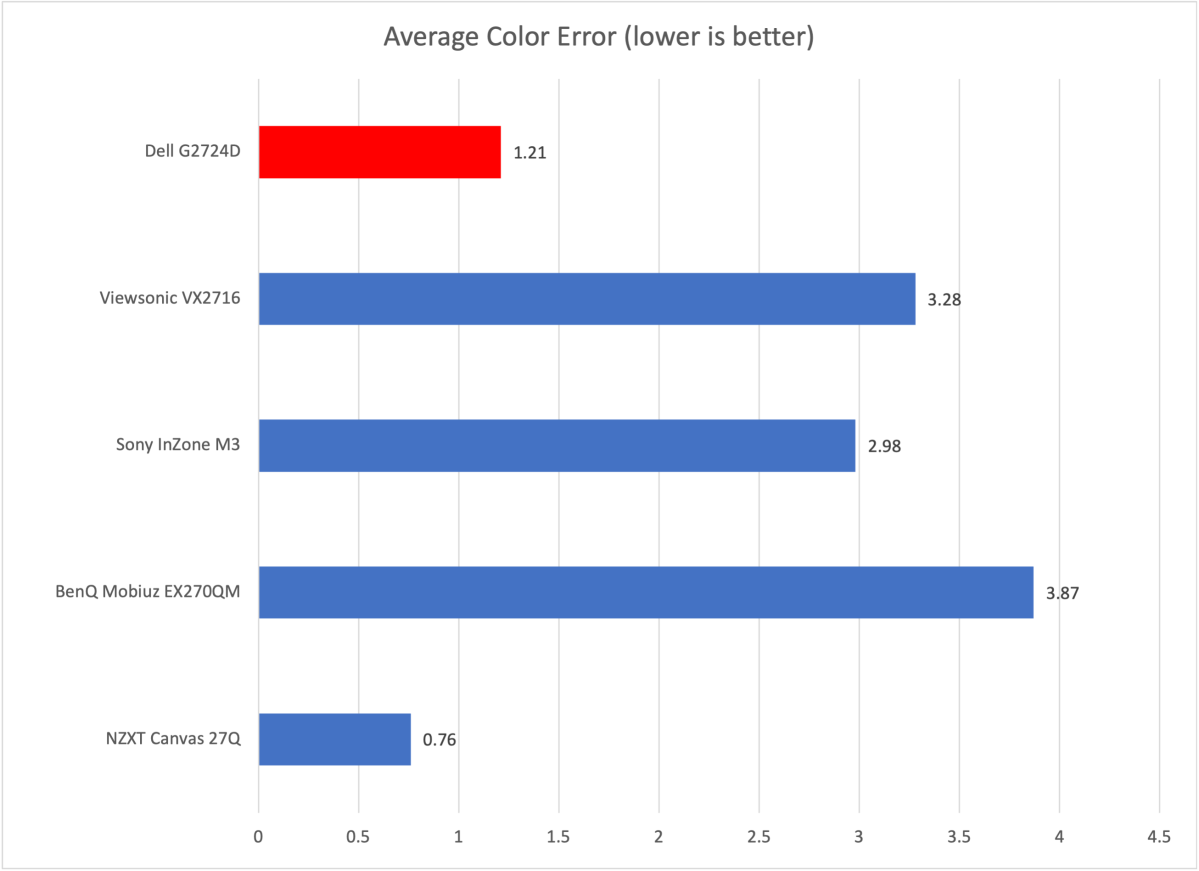
Matt Smith/Foundry
Color accuracy turns out to be a highlight for the G2724D, which performs better than most competitors except for the NZXT Canvas 27Q. Color appears realistic and lifelike and holds up well against similarly priced monitors.
The monitor’s color accuracy is aided by good gamma and color temperature results. I saw a gamma curve of 2.3, which is slightly off the preference of 2.2. This indicates content may appear a little darker than it should, but it’s not enough to cause serious concern. Color temperature is excellent at a default of 6600K, which is barely off the preferred target of 6500K. The monitor’s white levels don’t appear overly red and warm or too cool and sterile, providing a realistic and inviting image.
The monitor delivers a sharp picture with a resolution of 2560×1440, better known as 1440p. It provides a pixel density of roughly 109 pixels per inch (ppi) across the 27-inch panel. A 4K 27-inch monitor has a much higher pixel density of 163ppi, but a 1080p alternative is notably lower at around 81ppi. The G2724D looks sharp in games, and I’d argue 1440p is preferable to 4K at this price point, as delivering acceptable frame rates at 4K will require an expensive video card. However, 1440p resolution is not the best for content creation, since it’s not possible to view 4K video or (similarly sized images) at their native resolution.
The Dell G2724D’s image quality results add up to great value for money. It delivers several wins, such as high brightness, good contrast, and strong color accuracy, and avoids any significant problems or downsides. It’s among the best currently available at $300 or less.
Dell G2724D HDR image quality
The Dell G2724D does well in SDR, but HDR is a different story.
Brightness is a problem. That might seem surprising given its results in SDR, and HDR brightness is roughly equal at a maximum of 442 nits. But while this level of brightness is more than adequate in SDR, it’s lacking in HDR, where brightness of up to 1,000 nits (or more) is preferable. The G2724D’s lack of brightness will obscure details in bright scenes that are visible on better HDR displays.
The G2724D lacks a dynamic backlight that can dim or brighten only small areas of the display, so even a small, bright object will cause the entire image to brighten. That’s a big problem when displaying a starfield in the night sky or explosions in a dark alleyway.
HDR is not a quality experience, and I don’t recommend buying this monitor if HDR is your priority. No monitor currently sold below $500 performs well in HDR, however, so this is an unsurprising result. Gamers who want excellent HDR on the PC should consider a monitor like the AOC Agon Pro AG27QZM, which retails for $1,000.
How is the Dell G2724D’s gaming performance?
Gamers will appreciate the Dell G2724D’s maximum refresh rate of 165Hz, which is available over both DisplayPort 1.4 ports. The HDMI 2.1 port is limited to 144Hz.
Motion clarity is much improved over a 60Hz monitor. Small objects and fine details are easy to see and moving objects present with modest motion blur. Scrolling test images from League of Legends and DOTA2 showed that character silhouettes and map terrain were easy to make out, as were character health bars. However, details like character names weren’t easy to see in motion. That’s the performance I expect to see at 165Hz, and most budget gaming monitors with an IPS display panel and a 165Hz refresh rate will deliver similar results.
Dell is ahead of the competition in its support for Adaptive Sync, a technology that improves motion fluidity and eliminates screen tearing. The G2724D includes official support for VESA Adaptive Sync, AMD FreeSync Premium, and Nvidia G-Sync. Most gaming monitors that support any form of Adaptive Sync can function with all three technologies, but most only seek certification for AMD FreeSync, which means G-Sync support is unofficial. I’m happy to see Dell go the extra mile to provide peace of mind for gamers who own an Nvidia video card.
Should you buy the Dell G2724D?
The Dell G2724D is the model of what a quality budget gaming monitor should be. It delivers everything that is required for enjoyable gaming, including attractive image quality, solid motion clarity, and fluid gameplay delivered over Adaptive Sync. My only serious complaint is the monitor’s lack of USB or audio-out connectivity and disappointing HDR, but given everything else that’s provided for $300, these downsides are trivial. The Dell G2724D is an excellent choice for any gamer on a tight budget.



